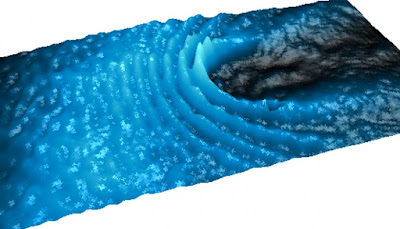There are two major theories that explains the nature of light - Corpuscular theory and the Wave theory. The Corpuscular theory of light was proposed by Issac Newton and was proved obsolete. Later, the Wave theory of light has been devising the physics of light. But, there emerged a new theory of light published in the journal Nature Physics.
According to this publication, light can also behave like a liquid besides being a wave. This means that light is capable of flowing around the objects. Not just flowing around, but the light is also capable of reconstituting itself on the other side of the object. Initially, this "bending" patter of light was observed only in an isolated laboratory with isolated temperature conditions - absolute zero temperature. After further research, the same pattern of light was reproduced in a room with room temperature and ambient pressure conditions.
On the other hand, the paper also published that light can behave as "superliquid". It means that light can flow around the objects without any friction or viscosity. As a superliquid, light can exhibit the properties that helps it for a complete "frictionless flow". The more interesting observation was that this property of light was observed in the room temperature with ambient conditions.
According to this publication, light can also behave like a liquid besides being a wave. This means that light is capable of flowing around the objects. Not just flowing around, but the light is also capable of reconstituting itself on the other side of the object. Initially, this "bending" patter of light was observed only in an isolated laboratory with isolated temperature conditions - absolute zero temperature. After further research, the same pattern of light was reproduced in a room with room temperature and ambient pressure conditions.
 |
| Image source: seeker.com |
In this way, we can combine the properties of photons — such as their light effective mass and fast velocity — with strong interactions due to the electrons within the molecules. Under normal conditions, a fluid ripples and whirls around anything that interferes with its flow. In a superfluid, this turbulence is suppressed around obstacles, causing the flow to continue on its way unaltered. - Stéphane Kéna-Cohen of École Polytechnique de Montreal.The capability of light to exhibit "superfluid" properties can be referred to as fifth state of matter. The same was proposed by Einstein and Satyendra Nath Bose in the Bose-Einstein, which was referred to as the fifth state of matter. The Bose-Einstein theory proposes that particles in the superfluid state behaves as single wave, where all the particles oscillate with the same frequency. In the fifth state of matter, the particles exhibit the combined attributes of solids, liquids and gases together.
The extraordinary observation in our work is that we have demonstrated that superfluidity can also occur at room-temperature, under ambient conditions, using light-matter particles called polaritons. - Daniele Sanvitto, lead of the research group.The very next implementation of this research is in electricity conduction. Such properties of light help in the conduction of electricity with zero resistance! Though the superfluidity property can be observed at room temperature, theoretically, it takes huge effort to create it practically. If scientists are capable of creating the same effect light under room temperature, this property of light is going to change the phase of the photonic devices like LEDs and Lasers. The same property of light can also be used in solar panels to generate higher energies from the light emitted from the sun. Also, photovoltaic cells will be capable of storing more power when this theory becomes practical.









